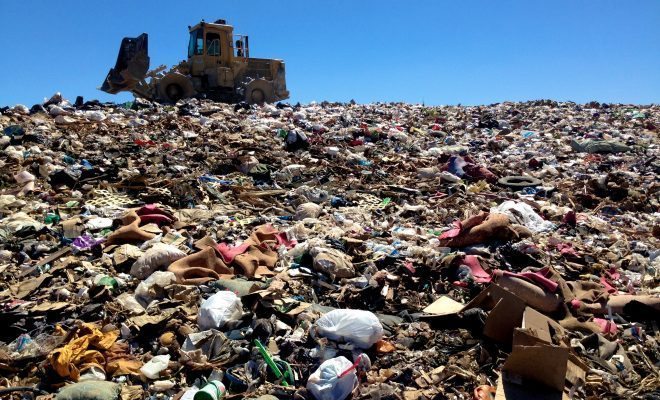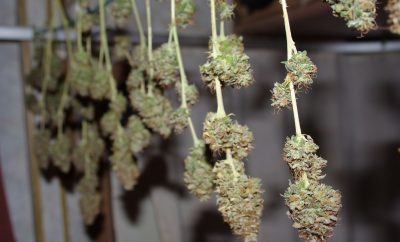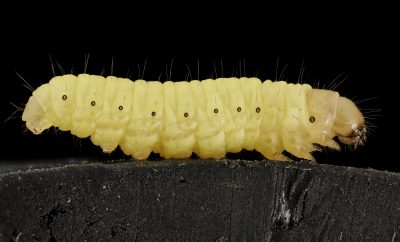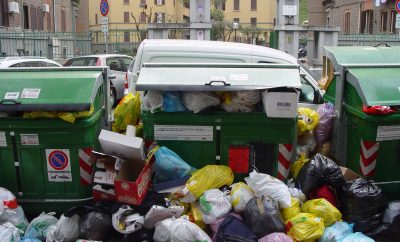 "King of the Trash Hill" courtesy of [Alan Levine via Flickr]
"King of the Trash Hill" courtesy of [Alan Levine via Flickr]
Energy & Environment
What Really Happens to Your Trash?
We buy products, use them, and then dispose of them. After we’re done with our stuff, we throw it in the trash and someone comes to take it away–out of sight, out of mind. But trash doesn’t really disappear; it takes up a larger and larger physical presence on our planet each year. In 2012, the world produced 2.6 trillion pounds of waste, all of which had to be disposed of. About 46 percent of that was organic waste, 17 percent paper, 10 percent plastic, 5 percent glass, 4 percent metal, and another 18 percent comprised of miscellaneous other materials.
Handled incorrectly, this 2.6 trillion pound mess can cause serious problems for the environment, from polluting freshwater to suffocating unsuspecting animals looking for a meal. Some of our trash gets buried underground, some of it gets burned, and some is thrown into the ocean. There are solutions that would allow trash to be made useful again, including composting and recycling. Organic waste, which makes up the majority of worldwide waste, can be turned into fertilizer and certain materials can be recycled to build new products. Read on to learn how different waste disposal methods work and what their exact impacts are on our planet.
Landfills
The vast majority of trash worldwide goes into landfills, which basically means that it’s buried in a huge hole in the ground. Generally, the bottom is covered with a liner, made out of clay or synthetic materials, that acts as a barrier preventing the trash from leaking into the surrounding environment. The waste is collected in different cells and as the cells fill up, they are covered and a new layer, or “lift,” is started above them. Over time, landfills produce a liquid called leachate that consists of dissolved and suspended trash materials. Because of this, landfills must also have a drainage system that collects the highly polluting leachate and stores it on site or at a wastewater plant for treatment. If leachate breaks through the liner, it can pollute ecosystems and ruin groundwater aquifers, making groundwater monitoring around landfills extremely important.
As the trash degrades, it releases carbon dioxide and methane, which inevitably rise up into the atmosphere. Often, the water soluble carbon dioxide will leave the landfill with the leachate, but methane release poses a serious problem to the environment. To control emissions, methane must be captured and contained in storage wells, where it is either burned off and turned into the less potent carbon dioxide or used as a power source. Because landfills create methane on their own and save the trouble of drilling for it, some companies have started to use landfill gas-to-energy systems, using the methane to generate power for the surrounding areas.
As a disposal method, landfills are far from perfect. Maintaining one is a constant struggle to control the polluting leachate released below and the heat-trapping greenhouse gasses that escape above. Furthermore, landfills are intended for waste containment, not waste elimination. The trash doesn’t go anywhere, it simply sits in the cells and piles up to greater and greater heights as the population increases and waste streams continue to grow larger. In this sense, landfills can be thought of as one of the most permanent things modern humans have created, giant holes filled with trash that will still be on earth long after the pyramids crumble.

“Landfill” courtesy of Wisconsin Department of Natural Resources via Flickr
However, landfilling waste is still preferable to, for instance, doing nothing with it. Some waste simply can’t be recycled or composted, and this stuff still needs a place to go. If we don’t contain our trash it enters the world and its ecosystems as litter and can cause great damage to the areas it inhabits. Possibly the most famous example of this is the Great Pacific Garbage Patch, a vast area of floating litter that extends between North America’s Western Coast and Japan. The trash is caught in a series of underwater currents called the North Pacific Subtropical Gyre, which carries it in a perpetual vortex. The trash is comprised of countless non-biodegradable items, such as clothes, machinery, and a giant soup of microplastics. Furthermore, the majority (about 70 percent) of marine debris sinks, which means that below the surface of the garbage patch, beyond where we can see, there may be an ocean floor covered with the denser trash that’s been dumped in the water.
Much of the debris in the ocean was dumped by cargo ships and commercial fishing vessels, but plenty of it was simply cast off from different countries. We do need a place to put all this stuff and landfills provide an important service in this sense. However, one of the big problems with landfills is that much of what’s inside of them doesn’t need to be there; if we were to remove the recyclables and organic waste from landfills it would cause them to take up significantly less space.
Can Recycling be an Effective Solution?
Some materials, paper, plastic, glass, and various metals can be recycled and used again to create new products (a lesser known recyclable material is actually cooking oil, which can be converted into biofuel for use as an energy source). Recycling is one of the most sustainable alternative methods of waste disposal out there. However, not everything can be recycled and even then, most recycling processes generally have low levels of efficiency.
Plastics, for instance, have a huge presence in ecosystems around the globe. Currently, we’re heading toward having more pounds of plastic in the ocean than living creatures. Plastic can suffocate animals that accidentally consume it and can also release harmful phthalates into the surrounding environment. Recycling is absolutely necessary if we want to save marine and land ecosystems from plastic litter. However, only one major type of plastic called thermoplastics, which can be softened by heat, are able to be recycled. The other major category, thermosets, cannot be remolded with heat. Because they can’t be recycled, it’s crucially important that they are still sent to a landfill because they can cause environmental harm if stored improperly.
Thermoplastics don’t undergo chemical changes when they’re exposed to heat and can be melted down and reformed into new products, making them work well as recyclables. While recycling a piece of plastic is never 100 percent efficient (and usually far from it), reusing plastics still has a powerful impact on the industry. About 60 percent of energy is saved when creating a plastic product out of recyclables instead of raw materials, and every piece of plastic that is recycled represents a piece that isn’t in a landfill, or worse, an ocean.
Paper, like plastic, has a fairly low level of efficiency when recycled. Pieces of paper must be shredded down before they can be reused, which continuously makes the fibers shorter and shorter. After five to seven times through the system, fibers become frayed to uselessness. In fact, aluminum, copper, and glass are the only materials that can be recycled endlessly. While they all go through different processes, each essentially amounts to exposing the material to extreme heat and breaking it down to be rebuilt in a new form. However, due to the high cost of reprocessing glass, many businesses don’t actually accept glass waste, or will merely throw it out when they receive it.
While electronic waste is made out of several recyclable metals, it also contains a number of rare earth metals, which can be dangerous when released into the environment or exposed to humans. Because of this, e-waste must be disposed of and recycled in a very particular way. Check out this previous Law Street article for an in-depth breakdown of global e-waste disposal.

“Landfill” courtesy of “Aaron ‘tango’ Tang via Flickr“
Composting
Organic waste makes up a staggering 46 percent of waste worldwide. Despite this, proper food waste disposal methods are rarely talked about. About two-thirds of the average household waste can be recycled; if citizens everywhere adopted the practice it would make a huge difference in the global waste problem. Adding compost to a garden can dramatically increase the health of the soil by neutralizing ph and binding soil particles together, enabling them to better retain water and nutrients.
One problem with composting is that most people don’t see any value to it. Unless you’re interested in personally growing something, compost won’t be useful to you. If you live in an urban setting, it most likely won’t be useful to anyone near you either. Some cities have programs that collect compostable waste in neighborhoods to supply nearby farms. This gives the people in the area reason to adopt the practice and provides a free source of fertilizer for farmers; it can also have the added benefit of educating people on problems of organic waste that they may have been unaware of.
The Role of Incineration
Incineration is one of the more controversial methods of waste disposal out there and it’s been growing rapidly in recent years, especially in Scandinavian countries. This process either burns (or melts down and then burns) all waste that enters a waste plant to convert it into energy. Many love incineration and its proponents say that it makes trash disappear, leaving no physical burden behind while also providing the useful service of generating energy. The temperatures inside incinerators are often so high that they also destroy harmful chemicals and pathogens, making them ideal for the disposal of hazardous waste. While incineration is practiced widely throughout Scandinavia, Norway is currently the world’s leader in turning trash into energy. Norway, in fact, imports trash from other European countries, earning it a profit and a free source of power.
Incineration does offer a way to change the way trash is looked at from a burden to a commodity. It’s nothing new for countries, states, and territories to export their waste for another area to deal with, but generally the importer only gains profit, and still has to deal with the burden itself. In the United States, for instance, about 17 percent of municipal waste crosses a state boundary and the trash trade was a $4 billion dollar industry in 2005. However, the trash market inevitably creates waste havens in states that decide to commit to the industry and build mega-landfills. Pennsylvania, for instance, is the trash capital of the country, importing 10 million tons of waste each year. This can benefit local economies, but is widely hated by the people who live in them. Many argue that incineration could make a significant difference in the way trash importing and exporting is handled. If waste is looked upon as a useful source of energy instead of something to be buried in the ground, then a state like Pennsylvania could use its position in the market to generate domestic energy instead of increasing the size of its dumps.
However, incineration is not without serious drawbacks. The trash burning process creates toxic emissions, although particulate matter, ash, and, toxins are collected in mandatory filters. As the ash builds up, it must be stored carefully on-site, and there’s currently no real way to treat or remove it. It’s also been argued that very small particles of ash and dioxins can still make their way through filters, which could be very dangerous to the health of those living near an incinerator. Furthermore, incinerators have an adverse effect on climate change, producing more carbon dioxide and mercury even than coal-fired power plants. They also release nitrous oxide, and ammonia, and organic carbon. Valuable recyclable materials such as glass, metal, and plastic, are completely destroyed during incineration, which is a huge waste of resources that could otherwise be recycled. The EPA concluded in a 2009 study that if the United States were to adopt large-scale recycling and composting, this could mitigate up to 42 percent of our national emissions. Incineration, on the other hand, destroys recyclables and produces emissions, further exacerbating the problem of global warming.
Conclusion
The world produces a lot of trash and we’re only going to produce more as time goes on. The worst possible option is to do nothing with all this trash and simply leave it to cover our forests and oceans. Landfilling is an effective alternative to this, making sure that all the trash is contained and, ideally monitored and controlled so it won’t hurt the environment. However, the landfills fill up and we keep making more trash. Responsible waste management requires us to keep sustainability in mind when we think about the way we dispose of our waste and what we send to the landfill.
Many governments advocate for waste to energy incineration, but ultimately this will only release more greenhouse gasses into the atmosphere and destroy valuable resources. Widespread composting, alternatively, could eliminate just about half of all the world’s waste, an absolutely enormous difference. While not every material can be recycled and not every recycling process is perfectly efficient, reusing our products can still have a huge impact by reducing the need to mine for more resources and the energy needed to process new products. If we want to make our trash more sustainable, then recycling and composting need to be the cornerstones of global waste disposal.
References
Aljazeera: Dirty Power: Sweden Wants Your Garbage for Energy
Apartment Therapy: What Really Happens to all that Stuff You Recycle
The Atlantic: 2.6 Trillion Pounds of Garbage: Where Does the World’s Trash Go?
Bright Hub Engineering: Pros and Cons of Incineration for Landfill Relief
Earth 911: The Benefits of Using Compost in Your Garden
The Guardian: Full Scale of Plastic in the World’s Oceans Revealed for the First Time
The Guardian: Trash to Cash: Norway Leads the Way in Turning Waste into Energy
Global Alliance for Incinerator Alternatives: Incinerators: Myths vs. Facts about “Waste to Energy”
International Panel on Climate Change: Emissions in Waste Incineration
National Geographic: The Great Pacific Garbage Patch
The Leachate Expert Website: What is Leachate?
Less is More: What Happens to Trash
Philadelphia: Is Pennsylvania America’s Dumping Ground?
The Trash Blog: Trash Trade in the U.S.
Republic Services: Landfill Science
SF Gate: How Many Times can Something be Recycled?
The Wall Street Journal: High Costs Put Cracks in Glass Recycling Programs
The Warren: Resistant Materials: Plastics
Washington Post: By 2050, There Will be More Plastic than Fish in the World’s Oceans, Study Says








Comments